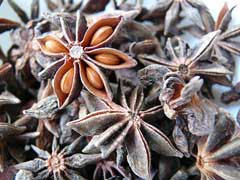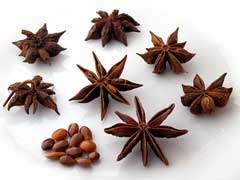 |
|
http://www.flickr.com/people/24363893@N00 |
 |
| http://commons.wikimedia.org/wiki/User:MarkSweep |
Translate this page:
Summary
Physical Characteristics

 Illicium verum is an evergreen Tree growing to 5 m (16ft) by 3 m (9ft).
Illicium verum is an evergreen Tree growing to 5 m (16ft) by 3 m (9ft).
See above for USDA hardiness. It is hardy to UK zone 8 and is frost tender. It is in leaf all year, in flower from March to May, and the seeds ripen in October. The species is hermaphrodite (has both male and female organs).
Suitable for: light (sandy) and medium (loamy) soils and prefers well-drained soil. Suitable pH: mildly acid and neutral soils. It can grow in semi-shade (light woodland) or no shade. It prefers moist soil.
UK Hardiness Map
US Hardiness Map
Synonyms
Plant Habitats
Woodland Garden Sunny Edge; Dappled Shade; South Wall. By. West Wall. By.
Edible Uses
Edible Parts: Fruit
Edible Uses:
The fruit is used as a flavouring in curries, teas and pickles[2, 132, 177, 238]. It is an ingredient of 'five spice powder', used in Chinese and Vietnamese cuisine[238]. The fruit is also chewed after meals in order to sweeten the breath[4]. Caution is advised because it is said to be poisonous in quantity[19, 177]. The essential oil is used to flavour liqueurs, soft drinks and bakery products[238].
References More on Edible Uses
Medicinal Uses
Plants For A Future can not take any responsibility for any adverse effects from the use of plants. Always seek advice from a professional before using a plant medicinally.
Antibacterial Appetizer Carminative Expectorant Homeopathy Stimulant
The fruit is antibacterial, carminative, diuretic, odontalgic, stimulant, and stomachic[4, 21, 61, 176, 240]. It is taken internally in the treatment of abdominal pain, digestive disturbances and complaints such as lumbago[176, 238]. It is often included in remedies for digestive disturbances and cough mixtures, in part at least for its pleasant aniseed flavour[238]. An effective remedy for various digestive upsets, including colic, it can be safely given to children[254]. The fruit is also often chewed in small quantities after meals in order to promote digestion and to sweeten the breath[4, 238]. The fruit has an antibacterial affect similar to penicillin[176]. The fruit is harvested unripe when used for chewing, the ripe fruits being used to extract essential oil and are dried for use in decoctions and powders[238]. A homeopathic remedy is prepared from the seed[4].
References More on Medicinal Uses
The Bookshop: Edible Plant Books
Our Latest books on Perennial Plants For Food Forests and Permaculture Gardens in paperback or digital formats.

Edible Tropical Plants
Food Forest Plants for Hotter Conditions: 250+ Plants For Tropical Food Forests & Permaculture Gardens.
More

Edible Temperate Plants
Plants for Your Food Forest: 500 Plants for Temperate Food Forests & Permaculture Gardens.
More

More Books
PFAF have eight books available in paperback and digital formats. Browse the shop for more information.
Shop Now
Other Uses
References More on Other Uses
Cultivation details
Prefers a light, moist well-drained loam and a sheltered position[1, 11] Prefers a humus-rich lime-free soil[182, 200]. Succeeds in sun or semi-shade[200]. This species is not very cold-hardy, it tolerates temperatures down to between -5 and -10°c and requires a very sheltered position or the protection of a wall when grown in Britain[200]. Chinese anise is extensively cultivated in China for its fruit and medicinal essential oil[200]. It is planted in the grounds of temples in Japan, and also on tombs[4]. Plants seldom grow larger than about 3 metres in Britain, but eventually reach about 18 metres tall in their native habitat[200].
References Carbon Farming Information and Carbon Sequestration Information
Temperature Converter
Type a value in the Celsius field to convert the value to Fahrenheit:
Fahrenheit:
The PFAF Bookshop
Plants For A Future have a number of books available in paperback and digital form. Book titles include Edible Plants, Edible Perennials, Edible Trees,Edible Shrubs, Woodland Gardening, and Temperate Food Forest Plants. Our new book is Food Forest Plants For Hotter Conditions (Tropical and Sub-Tropical).
Shop Now
Plant Propagation
Seed - it does not require pre-treatment and can be sown in early spring in a greenhouse[113]. Prick out the seedlings into individual pots when they are large enough to handle and grow them on in the greenhouse for at least their first winter. Plant out in late spring or early summer, after the last expected frosts, and give some protection from the cold over the winter for the first year or two. Layering in early spring. Takes 18 months[78]. Cuttings of half-ripe wood, August in a frame[113]. Pot up the cuttings when they start to root and grow them on in the greenhouse for their first winter, planting out after the last expected frosts.
Other Names
If available other names are mentioned here
Native Range
TEMPERATE ASIA: China (Fujian Sheng (south), Guangdong Sheng (west), Guangxi Zhuangzu Zizhiqu, Yunnan Sheng (southeast)) TROPICAL ASIA: Vietnam
Weed Potential
Right plant wrong place. We are currently updating this section.
Please note that a plant may be invasive in one area but may not in your area so it's worth checking.
Conservation Status
IUCN Red List of Threatened Plants Status :

Growth: S = slow M = medium F = fast. Soil: L = light (sandy) M = medium H = heavy (clay). pH: A = acid N = neutral B = basic (alkaline). Shade: F = full shade S = semi-shade N = no shade. Moisture: D = dry M = Moist We = wet Wa = water.
Now available:
Food Forest Plants for Mediterranean Conditions
350+ Perennial Plants For Mediterranean and Drier Food Forests and Permaculture Gardens.
[Paperback and eBook]
This is the third in Plants For A Future's series of plant guides for food forests tailored to
specific climate zones. Following volumes on temperate and tropical ecosystems, this book focuses
on species suited to Mediterranean conditions—regions with hot, dry summers and cool, wet winters,
often facing the added challenge of climate change.
Read More
Expert comment
Author
Hook.f.
Botanical References
200266
Links / References
For a list of references used on this page please go here
Readers comment
© 2010, Plants For A Future. Plants For A Future is a charitable company limited by guarantee, registered in England and Wales. Charity No. 1057719, Company No. 3204567.